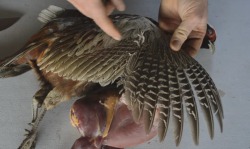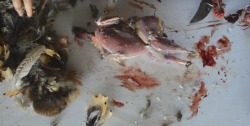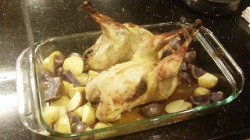When calamity strikes and grocery stores become barren, it will be imperative for people to produce their own food. Many individuals who have never hunted will be forced to learn quickly. In my own experience, I’ve found field dressing, not shooting, to be the most challenging part of the hunt. Among those who have never hunted, the prospect of cleaning a bird is probably intimidating.
By D-Ray a contributing author to SHTFBlog
Thankfully a YouTube user, Shawn Woods, has an informative video on how to clean a pheasant in under two minutes. Whether you’re a seasoned hunter or a novice, this video is impressive. Novice hunters will learn how to expertly field dress and more seasoned hunters can appreciate a speed run.
A Breakdown of the Process
To begin, it is important to understand you are working with six components for removal: head, tail, two wings, and two feet. First, let’s take a look at the legs of your pheasant. The lower, scaled half of pheasant legs connects to the feathered top at a joint. In a circular motion, cut just below this joint and snap the leg of the pheasant back. At this point, the leg should be hanging on by a few tendons. Cut any excess tendons and remove the lower portion of the leg.
Next, you’ll want to focus on the wings. Pheasant wings are separated by a joint dividing primary and secondary feathers. Grab 
Now for the good part. Grab the base of the pheasants neck and cut. Without too much effort, this will come right off. Remove the pheasant head and use this opening to peel back skin and feathers. With the exception of the remaining secondary feathers, removing this skin should not be too difficult. For the most part, this should be a quick process.
To conclude, cut the pheasant tail at the base and remove. Next, make a small cut along the lower breast portion; this will create 
At the end of this process, Shawn Woods produced a cleaned Pheasant in 1:44 seconds. Perhaps the most impressive part of his process is meat retained. Very little was wasted in this process. Although he did not mention it, pheasant liver and gizzard can be consumed as well. In a survival scenario, you will want to hold on to these for consumption.
What the Video Missed
While I was impressed with this video, I must throw in a few caveats. You should not emulate the haphazard process of organ removal used in this video. Take a bit of time to carefully remove intestines and other internal organs. Rupturing these inside the pheasant is messy, unhygienic, and smells god-awful. Nobody wants to clean pheasant meat that has been covered in bird feces.
A less important note: when removing the legs, don’t sever the tendons outright. Take a bit more time to pull them out of the 
It’s also important to mention that a thorough cleaning process involves looking for shot embedded in the meat. You don’t want to start digging into your pheasant meat to chew down on a mouth full of metal. The bird in this video seemed to be killed in a pretty clean fashion. This isn’t always the case. From time to time, you will kill a pheasant that is, at points, too mangled by shot to be consumed. In these instances, you will be forced to toss ruined meat.
Wrapping It All Up
As this video demonstrates, cleaning a pheasant isn’t an overly difficult or time consuming practice. If you remember to cut your six components and take time to skin, you will produce a cleaned pheasant ready to cook. Also, if you’ve never been hunting, I recommend you go. Bird hunting is a great deal of fun and a valuable skill in survival scenarios. If you need an excuse to take a few days off and shoot a shotgun, bird hunting is the perfect activity. I challenge you to find an unhappy hunter after a trip out to the woods. The old adage ‘a bad day of fishing beats a good day at work’, is also applicable to hunting.
For the seasoned hunters out there, what is your process? While I think a two minute clean is a little hasty, I was still impressed with the speed clean. Let me know what you think in the comments. Also, feel free to share your hunting experiences.
Photos and Video Courtesy of:
Shawn Woods
California Department of Fish and Wildlife
Lukasz Lukasik

5 comments
Many yrs ago, I worked in a custom butchering house that processed all kinds of livestock, including chickens. I learned in hurry how to ” do ” a chicken and I still do a pheasant the same way. I split the skin at the base of the breast to the bottun of the neck, then peel the skin away to the wings ( at which time I cut the wings off with a sharp knife thru he joints), then removing the skin from the legs and the lower part of the leg and foot at the knee joint. then I open the body cavity ( wide open ) and reach in and pull everything out, being careful not to break any organs. then washing with cold water and redoing or checking for anything that would or will cause problems.As far as pheasant hunting is concerned, I’ve had some very nice nature walks out in the fields, watching my dog run his ” you know what off “. Just saying.
Thanks pretty informative.
Great read D-Ray. Thanks for the info. And good call on the hygiene. The guts can be toxically messy, and there will still plenty inside the bird that a two-finger swipe won’t remove.
My 2 survival cents are to do an analysis of the stomach contents. Knowing what a critter eats or prefers to eat when the pickings are good will focus your hunt. Whether fish or fowl, there are plenty of clues to help take randomness and luck out of your hunt.
I gutted some birds over the weekend with a knife I’m testing right now. It’s bigger than the one in the video, but retains a full belly and instead of doing a twist on the limbs, I cleanly slice through them with a rocking of the blade. I think it’s also much safer than repeatedly picking up the knife especially when the workspace is covered with feathers and slime.
Thanks, Doc. Those are great tips. If I ever write a follow-up piece, I’ll have to include them.
Oh course the hardest part is getting past the beauty of the animal long enough to kill it! And the best part is eating it! Nice technique, much faster than what I learned but seldom get to use, thank you! GLAHP!